Analogue computing.
#linklists
#threads
Devine Lu Linvega: original thread
I’m doing a bit of research for a talk, could you send me anything relevant to paper computing, diy punchards machines, graph-paper coding, vedic mathematics, mechanical programming, and other things you have stumbled upon that you found interesting related to computerless computing?
conclusion post
A big thanks to everyone who've collaborated to this thread. So many amazing ideas in there, that will help me tremendously.
I've collected many of the suggestions from this thread about non-electric computers on this page here:
If you have any suggestions that you find are missing from the list, send them over :)
Devine’s post-thread wiki page
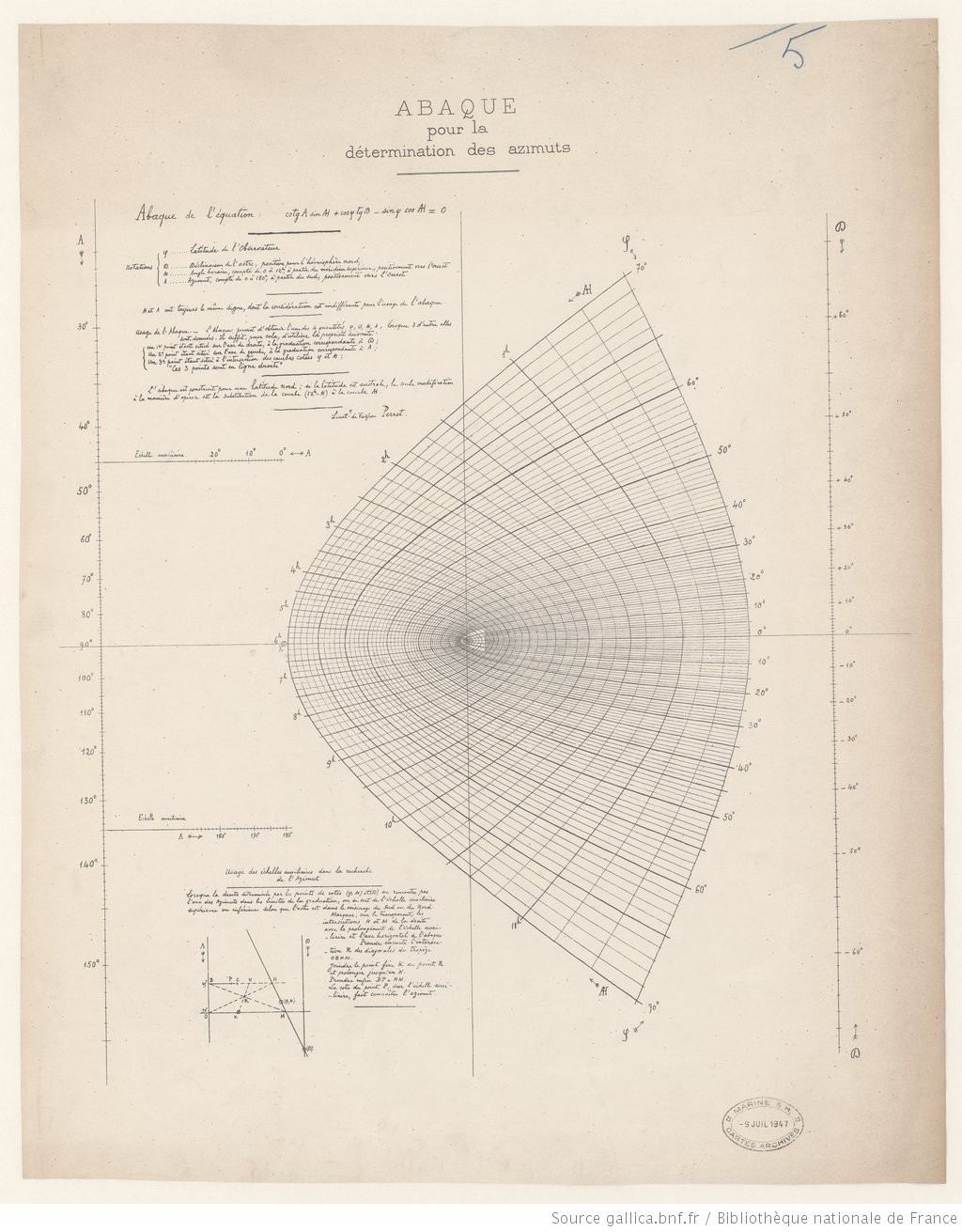
(note from zen, Jan 26 2021: sorry for the somewhat narcisistic arrangement of this archive, it was just a private note, hastily edited and posted publically to score a quick internet point. Now I want it to make some kind of linear narrative sense, so I seperated my big overwhelming linkdump from the rest. I hope that helps the other wonderful contributions stand out on their own)
a not entirely complete link summary:
- Logic Gates - Album on Imgur
- 1.2 From the abacus to Hindu-Arabic numerals | Bit by Bit
- modern nomograms
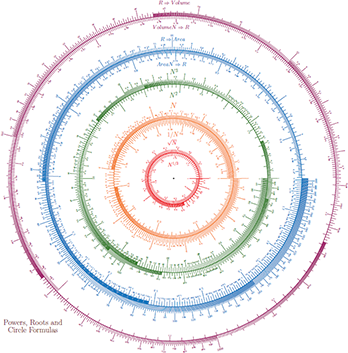
- Paper Record Player on Vimeo
- Dead Reckonings – Lost Art in the Mathematical Sciences
- in Stephenson’s The Diamond Age, the Primer has several interesting computer-less computing stories.
- Ghana Patha - Vedic Chanting as an encryption algorithm.
- ekay (@ewankeep@mspsocial.net) I have a few things on Vedic mathematics, Korean finger math, abacus, mental math and slide rules. I’ll look up authors and links when I get back to my desktop.
- read anathem cancel @cancel
- SPICA pump GPIO27 @bamfic@hub.spaz.org
- https://zkm.de/en (KABALA COMPUTER)
- https://m.youtube.com/watch?v=8BOvLL8ok8I
- https://books.google.it/books?id=KRtetV1MJnkC&pg=RA1-PR45#v=onepage&q&f=false
- http://lapinozz.github.io/learning/2016/11/19/calculator-with-caordboard-and-marbles.html
- https://charlesreid1.com/wiki/Lono_Computing
- https://de.m.wikipedia.org/wiki/Papiercomputer_(Vester)
- @neauoire I don’t know if Mechanical computers (https://www.youtube.com/watch?v=s1i-dnAH9Y4 , https://www.youtube.com/watch?v=hIinz4fKGpo ) qualify since they are computers, and were canonical for a long time; There is also the “experiment” of Scott Aaronson (https://www.scottaaronson.com/blog/?m=200708) to disprove this:https://arxiv.org/abs/cs/0406056 which could be considered as an automated proof without computers (half joke)
- https://www.halfbakedmaker.org/blog/116
- https://www.csunplugged.org/en/topics/
- https://esolangs.org/wiki/Efghij non computer computer game made out of household objects
- https://en.m.wikipedia.org/wiki/Norbert_Wiener cybernetics
- optical illusion computer
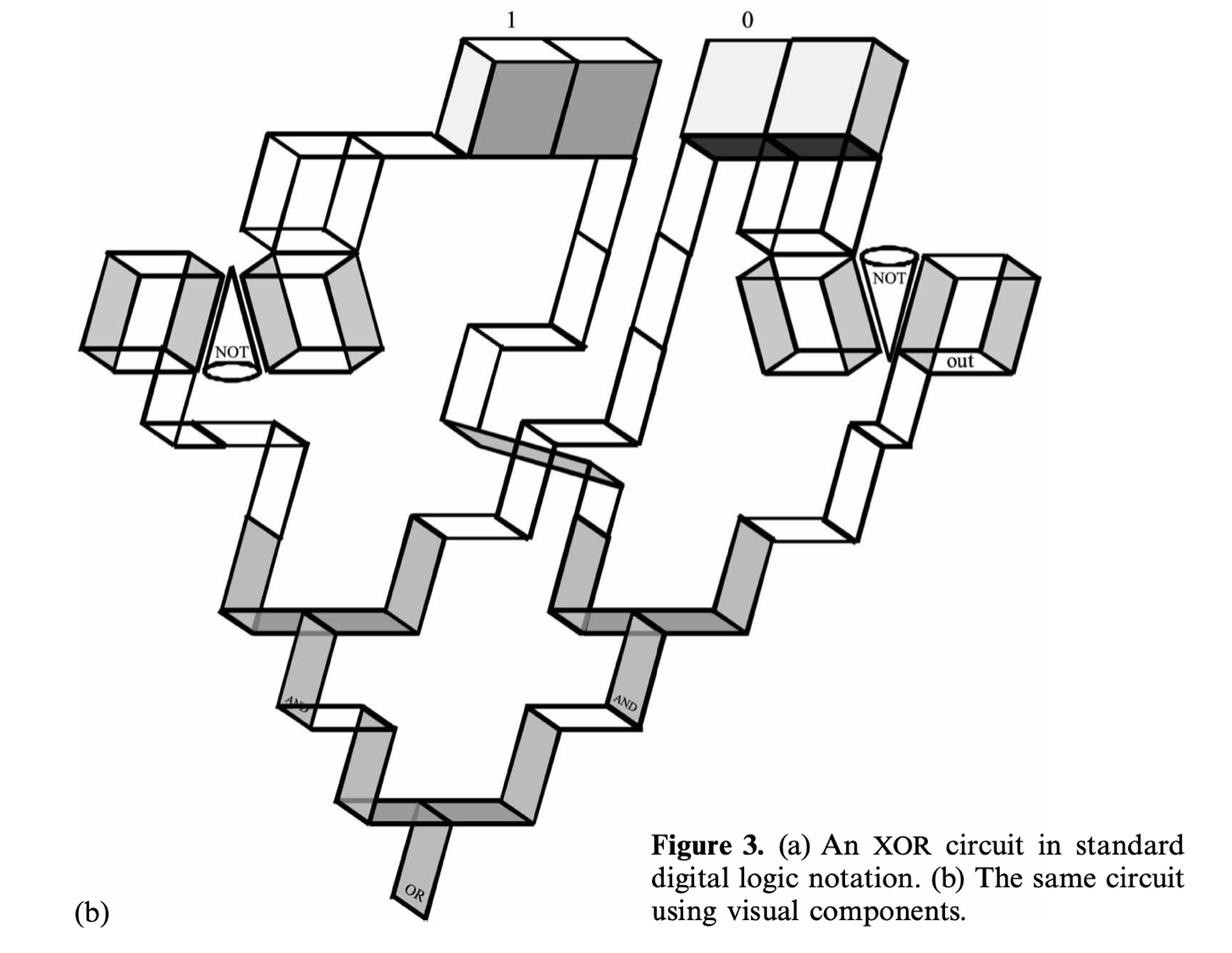
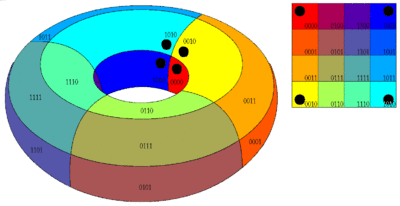
Zen’s (that’s me) initial link spree
oh! i’ll see what i’ve got in my analogue cyberpunk tag
A history of optical synthesis

macbee quicksort cards (generic name: edge punch cards. used for computerless computing)
aperture cards: punch cards with a microfische in the middle- the punches are used for indexing and retrieval of the content on the film.
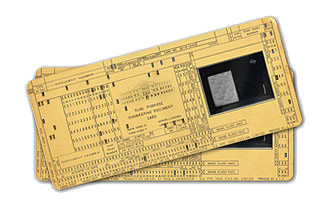
the drum on this electromechanical balistic comouter encodes a 2d function, with inputs fed in by the intrumentation of the bumber plane. the function determines the exact moment to drop the bomb to hit its target
https://twitter.com/foone/status/1301877428998926336?s=21
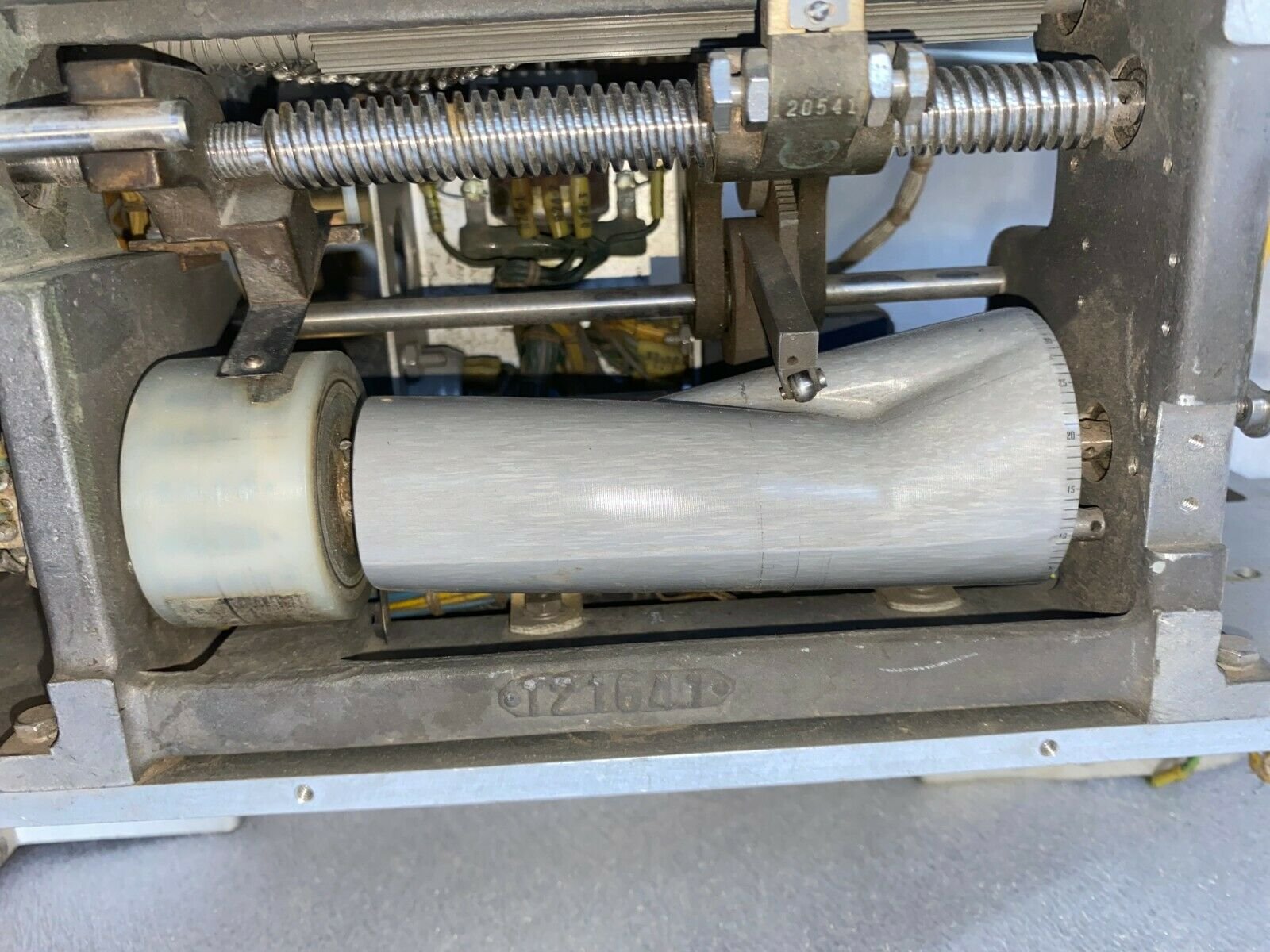
this episode of vsauce walks through the process of building and using a matchbox and bead based computer
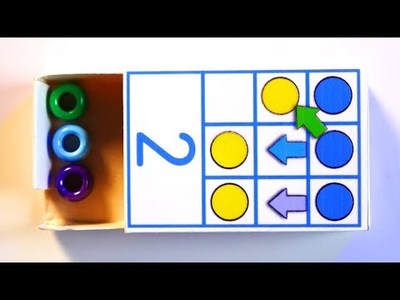
“the engine” from gulliver’s travels
https://en.m.wikipedia.org/wiki/The_Engine
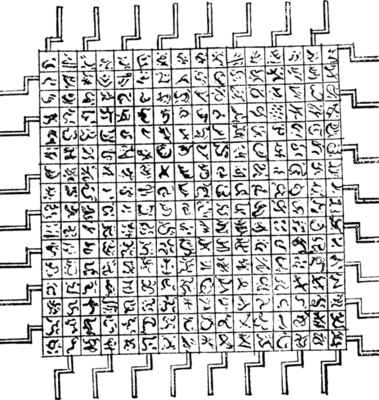
a series of gifs demonstrating various logic gates as rope and pulley systems
https://imgur.com/gallery/I7wFi
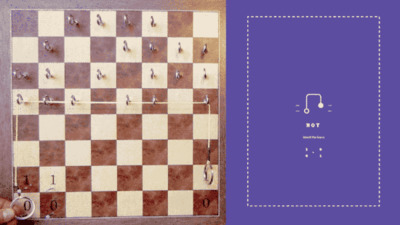
I kindda want to build one.
MONIAC is a water based computer that models the world economy as a set of columns of water and differential pressure systems stablizing at a equilibrium pressure.
Terry Pratchet based a discworld book on it.
https://en.wikipedia.org/wiki/MONIAC
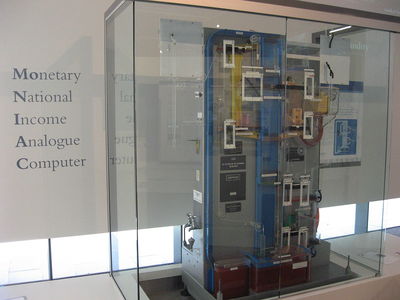
John Conway (of game of life fame) built his own Water computer named WINNIE

http://nautil.us/blog/this-early-computer-was-based-on-a-urinal-flush-mechanism
more about water computers, with speculation that those lavish eurpean royal gardens with huge labyrinths and water fountains may have been secretly used as computers for political and military strategy.
https://hplusmagazine.com/2013/05/10/gardens-as-crypto-water-computers/

The wikipedia article only says "ancient india" and doesn't say how far back it could go.
but, the vedic game known to us as "Snakes and Ladders" is structurally equivalent to a finite state machine, so you could, in principle, implement regular expressions and program language parsers as games of snakes and ladders.
https://en.wikipedia.org/wiki/Gyan_chauper
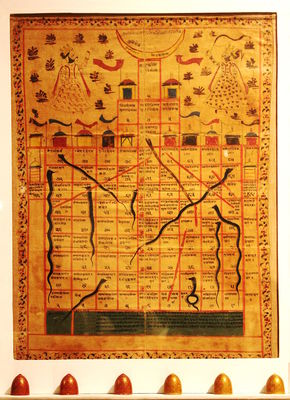
an aperiodic tile pattern in a 12th century islamic temple, using "girih" tiles, was found to be mathematically equivalent to the penrose tiling. I could go on for hours on this topic, but to relate it to THIS One, Roger Penrose used this aperiodic tiling in a mathematical proof that computers can't replicate human intelligence.
https://www.nature.com/news/2007/070219/full/news070219-9.html
this wooden marble machine implements a binary adder
https://makezine.com/projects/make-20/marble-adding-machine/
http://www.youtube.com/watch?v=GcDshWmhF4A

Spiders offload some cognitive tasks and memories into the design of their webs.
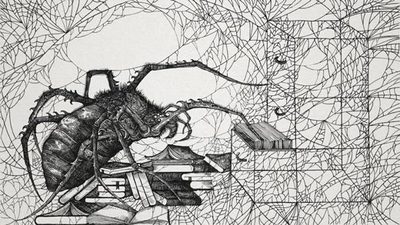
This would make the web a model example of extended cognition, an idea first proposed by the philosophers Andy Clark and David Chalmers in 1998 to apply to human thought.
The tenseness of threads reflets the level of attention a spider is paying to that direction. Artificially tightening the web puts spiders on high alert. Starving the spiders leads them to tightening the web, to catch smaller prey. Internal state reflects external state, external state reflects internal state.
When experimenters start cutting out pieces of a web as it’s being built, a spider makes different choices — as if the already-built portions of silk are reminders, chunks of external memory it needs to retrieve so it can keep things evenly spaced, Japyassú said. Similarly, what happens in a web once it is built can change what kind of web the spider builds next time. If one section of the web catches more prey, the spider may enlarge that part in the future.
this one time, in the 1990's, NASA's jet propulsion library filled a jug with jello, stuck electrodes into it, and somehow coerced it to behave like a neural network. I have no idea how this worked.

And even though, as a sailor, you very likely know aaaaalll about these, I figure I should add these because it turns out my analog cyberpunk tag was empty, and I've been building this list up from memory.
- Antikythera Mechanism
- Sextant
- Astrolabe
- John Harrison's H4 Marine chronometer, the world's first clock accurate enough for longitudinal position calculation.
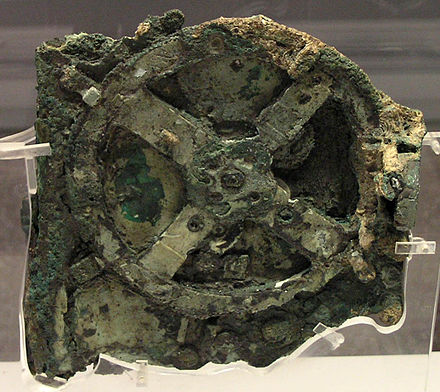
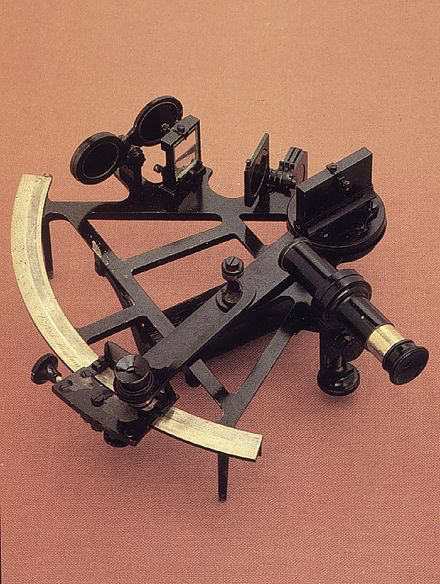
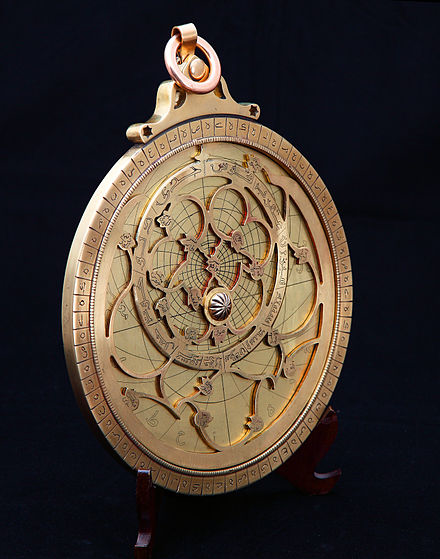
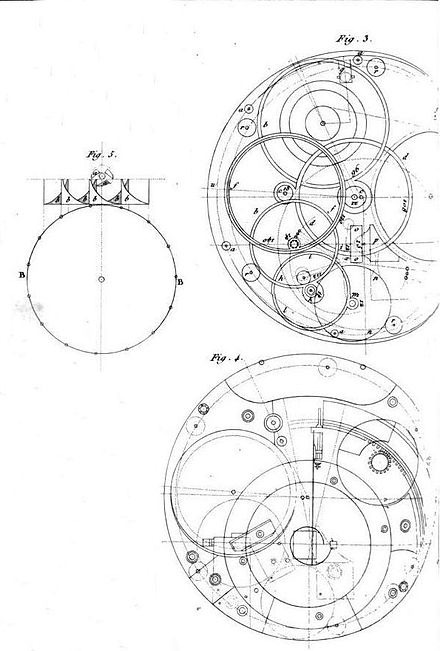
mamluk era astrolabe
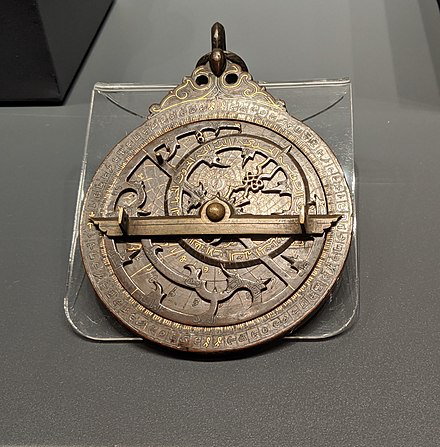
a bit more mundanely, I used to use a proportion wheel back when I was studying to become a printer.
real growth industry that one. That career move really panned out.
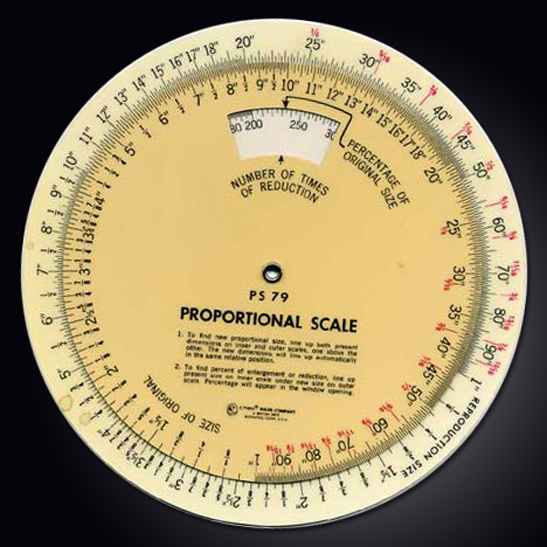
Oh god, you too! Damn, I had one of those too. Used them when working on stat cameras. Compugraphic typsetting machines (with punched tape teletype and film cartridges). Paste-up. AB Dick and Ryobi offsett presses. Christ. Did that for money in college and afterwards.
i was just slightly late, never made a dime.
plus there’s this thing where a certain kind of person will take an instant dislike of me. turns out that most printers are that kind of person.
Most printers are functional alcoholics, IME.
the first machine to actually be called a “computer” (previously, it was a job description) was something like a very big fancy gun. it even has three pistol grips.

these tracks and carousel of pins implement the timing and sequence program and selection memory of a wurlitzer jukebox. pressing a buttton to select a record pushes a cooresponding pin up. as the drum spins, a metal brush arm closes a circuit with the 5 tracks to switch on and off the robotics motors at appropriate moments, and the selection pins stop the drum spinning at a soecific point in the cycle.
it’s explained in detail here

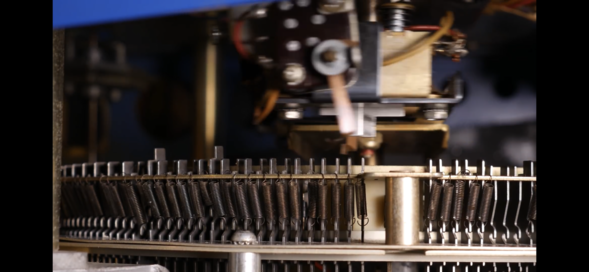
paper tape being read at 2400 baud
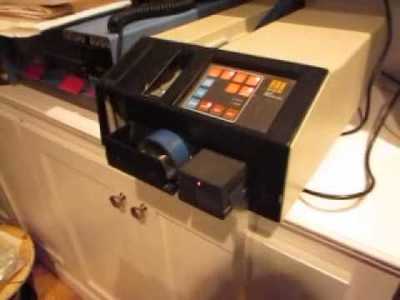
the Curta hand crank calculator
https://en.wikipedia.org/wiki/Curta
it does multipiclation by repeated addition!
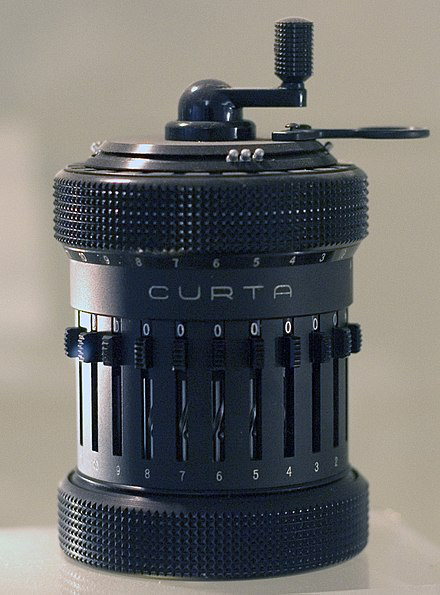
this japanese multiplication technique
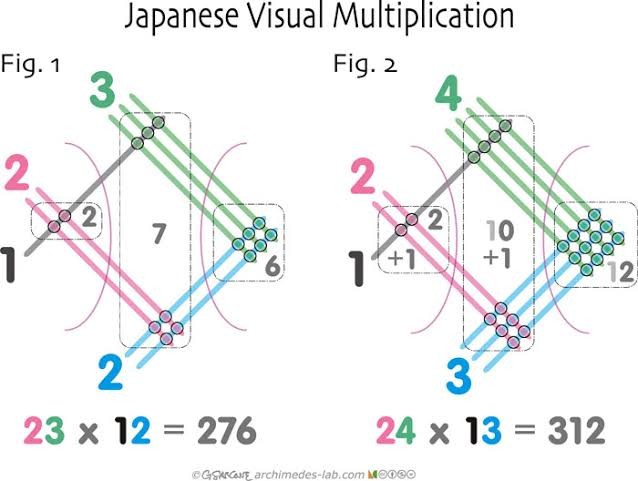
I usually call that vedic multiplication :D But that's exactly what I'm looking for more examples of!
You know about antilog tables, I presume?
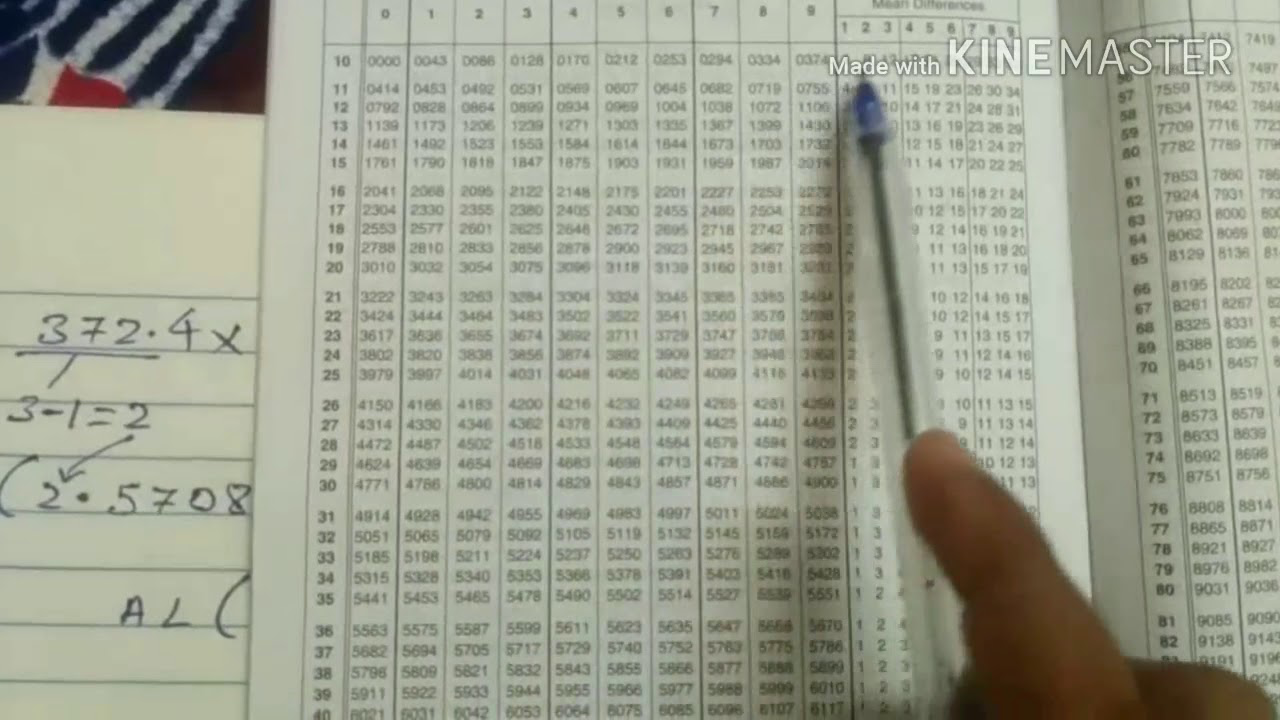
yeah I think so, that’s just multiplication tables right?
Not exactly no. It was these thick books ships navigators used to bring along, along with a confusingly named companion "log table book".
the idea is you could do multiplication very quickly by taking your two input numbers, finding the corresponding logs, ADDING those together, and then finding the antilog of the result.
similarly division could be accomplished with subtraction.
errors in these books is what motivated babbage to try and invent a computer machine.
Oh wow, like a dictionary of multiplication tables!
well sort of, yeah.
there was a whole field of human computers whose job it was to compute by hand the figures in these books.
the principle of the sliderule was essentially the same.
If you take a ruler and space the numbers apart according to a logorithmic progression, you can sorta offset the two halves by some amount and get a dynamic multiplation/division calculation.
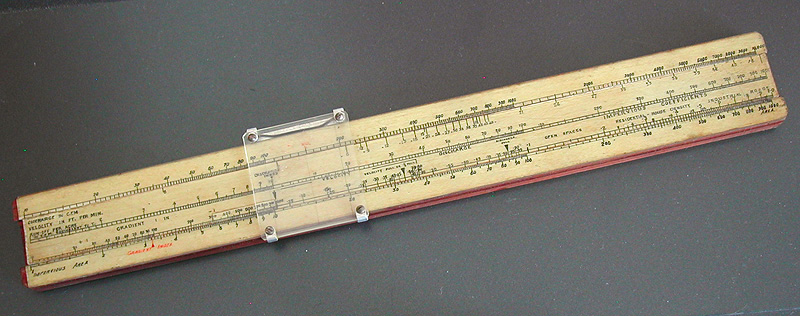
Do you happen to know other games like tictactoe that can be played on paper using a paper interface?
Hangman comes to mind.
For some reason I can't think of any others.
i just remembered a similar trchnoque for computing percentages- e.g. numbers between 0-1 multiplied by each other.
where you kinda draw two rectangles in w box and the area they overlap is the answer.
yes, optical computers are very interesting to. i can’t remember enough details to find it again but i remember reading about a computational process that involved engraving a function into a lense with lasers, and inputting the tensor input value as a digital image into the optics and collecting the output image as the result.
along similar lines, a team managed to compute the precise shape of glass you need to project some specific image as caustics patterns
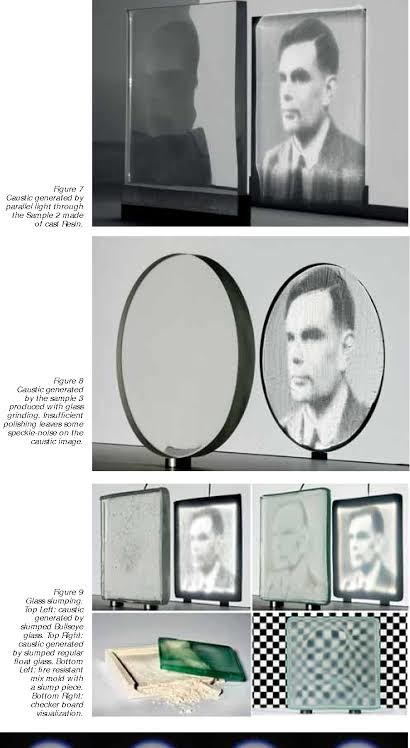
i didn’t mention it before, because it’s not an actual thing that exists, but i had the idea a while ago of trying to work out how to develop a morse code message decoder as a set of optics that takes a llight pattern and feeds it through a set of optical logic gates.
you could also maybe, in principle encode the weights of a neural network into a a series of glass sheets this way.
artificial neural network that is-
haha imagine though, a perfect simulation of a human brain imprinted as a hologram into a sheet of glass, only thinking and being alive when light is shined onto it.
And thus began the first billion dollar Mastodon startup... count me in ;)
the one quality of optical computation processes that makes it worth using is that a lense is intrinsically an instantaneous fourier transform
so, if your computation involves a lot of fft and inverse fft, optics could potentially speed it all up
(continuing from earlier post about macbee edge punch quick sort cards)
an actual link about the mcbee quicksort cards. Stewart Brand, a pivotal figure in 1960's internet culture, (they apparently knew an internet was coming and they proceeded to act like it was already there using whatever was to hand) Stewart Brand swore by the McBee cards until computers obsoluted them. Then he switched to hypercard, which were, on some level, an emulation of these cards.
https://kk.org/thetechnium/one-dead-media/
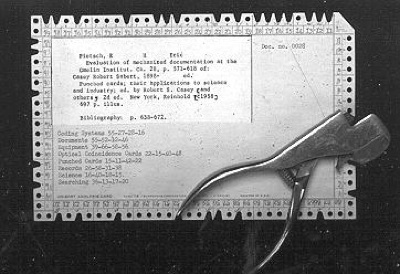
Wow, this is a fantastic idea. You’d have to take care and the cards would have to be real sturdy for the notches not to break.
Image: A stack of McBee or InDecks cards. A screwdriver-like needle has been pushed through one of the category holes of all the cards. The needle is lifted and pulls out all the untouched cards, while the ones with their notch removed remain.
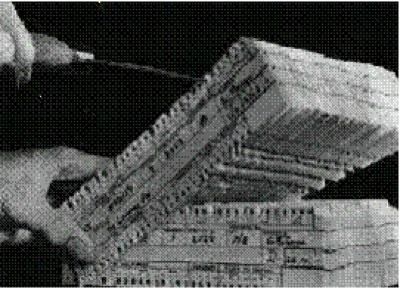
the real trick is in the categories you select, which is pretty hard to figure out up front.
libraries apparently had great success with these.
the scanimate was an analog computer built for motion graphics prominent in the 1970s and 1980s in sesame street and 3-2-1 contact.
it's essentially a big complicated modular synthesiser that outputs to an oscilloscope with a camera pointed at it with some sync circuits. It also contains a frame buffer memory for a 1 bit threshold image, and a compositor which they used to build up complex images by overdubbing and feeding the buffer through distortion filters.
https://www.youtube.com/watch?v=wTO3CKM2Yy0&feature=youtu.be

YHANCI~1.TXT @yhancik@octodon.social
Zens you’ve been killing it with these links, so good!
no kidding!! this is such an amazing thread. Thank you so much!
I love this thread so much. If I could hug a thread, I would hug it. I just love it. It should be preserved somewhere as like a blog post. THIS is the kind of thinking we desperately need: go back to first principles with computing, go back before first principles, and start over.
well, i know i am preserving it for myself. when/if i get my text website going, the post will go there.
not to prevent anyone else from doing the same
The rest of the wonderful replies
The Three Body Problem has this really cool sequence where a general uses a million-strong army to do computations, with each soldier simulating a single bit by holding up a red or blue flag.
eviloatmeal @eviloatmeal@linuxrocks.online
Maybe clocks / watches are tangent to that topic? I don't have any particular info, just a thought.

in Stephenson's The Diamond Age, the Primer has several interesting computer-less computing stories.
you should read Anathem
does the prose & gibberish words in anathem become easier to get through? i gave anathem a try once and was turned off by the verbose made up vocab
yeah, at the beginning you don't need to understand it. There's also a glossary if you need it.
i had a hard time starting it for the same reason, but once the story gets going it starts making more sense. there's an exercise in trying to figure out what they're talking about, but you can also use the glossary, or just ignore it.
happy to hear that :)
Michael Wolf @grumpy@grumpys.online
these may be pretty basic but Godel Escher Bach and
https://www.nytimes.com/2019/05/17/science/math-physics-knitting-matsumoto.html

thanks :)
banana nana fo fana @eli_oat@dog.estate
dot and boxes,
▼Platinum Ship of Fools @conatus@octodon.social
did you have this one already (dots and boxes)
https://en.wikipedia.org/wiki/Dots_and_Boxes
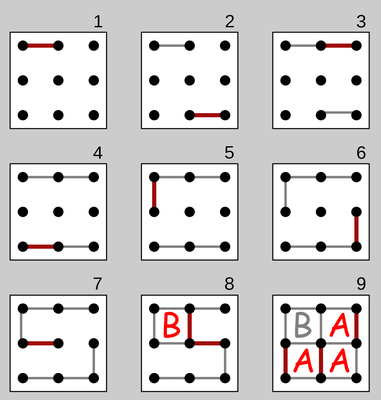
dozens@dozens@tiny.tilde.website
sprouts
https://en.m.wikipedia.org/wiki/Sprouts_(game)
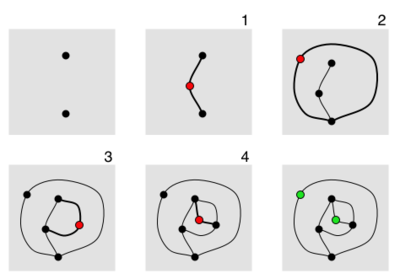
yeah, I have it written as Capture.
Alex Schroeder @kensanata@octodon.social
Trying to find a source for this on Wikipedia led me to a different multiplication method I hadn't heard before:
https://en.wikipedia.org/wiki/Lattice_multiplication
Michael Wolf @grumpy@grumpys.online
similarly, William Gibson's Difference Engine describes a massive pneumatic computer which reminded me of the Paris Pneumatic Clock Network (the original NTP)
I would like to find something like that to exemplify Artificial neural network
There's also the Norden bombsight from WWII, which was super top secret during its time. It gets mentioned in Catch-22 which is how I found it:
https://en.wikipedia.org/wiki/Norden_bombsight
Also, a super basic example is those paper wheels that sometimes come with stuff... I guess they're really just lookup tables, but still interesting. Lookup tables in table form are interesting in and of themselves, ie. in the back of statistics books or camera lens charts. There's usually a very specific procedure for using them, otherwise they don't make any sense.
Lenses are cool too, especially complicated zoom lenses, with things moving very precisely in both directions as you rotate the ring...
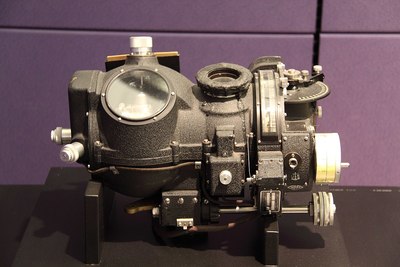
clacke@libranet.de (Dec 22)
My elder brother taught me a paper racing game when I was a kid, and we played it a lot.
Use graph paper, the one full of 5 mm squares, draw a race course. Just two lines, squiggling around the page as the right and left side of the course. Draw a start/finish line.
Now you take turns driving your car from a point each on the start/finish line. A point is an intersection of graph lines.
You start by going one step forward. Draw a line from your starting point and one step forward.
For your next step, your horizontal and vertical speed each need to increase or decrease by one, or you continue at the same speed. So you need to go to either to the point that you would go if you continue at the same speed, or you go to one of the points that form the corners of a 2x2 square around that point.
Go outside the course, you crash. Go to a point where your opponent is, you crash. First one across the finish line wins.
It’s important that you only have 5 choices for next step, not 9. You may even decide to disallow coasting, and only have 4 choices. This is the restriction that allows the other player to interfere with you and force you off the course, or force you to take a longer path.
The limitation (+- 1 only) on turning and accelerationdeceleration forces you to slow down before curves on the course.
Ramon Llull
There was an exhibition in the ZKM about Ramon Llull.
As i understood Ramon Llull is working on a system to generate philosophical questions.
This can be build as a „paper calculator“. Have only the German version of the booklet.
“DIARRHOEA-LOGOS”: Ramon Llull and the ars combinatoria • Digicult | Digital Art, Design and Culture
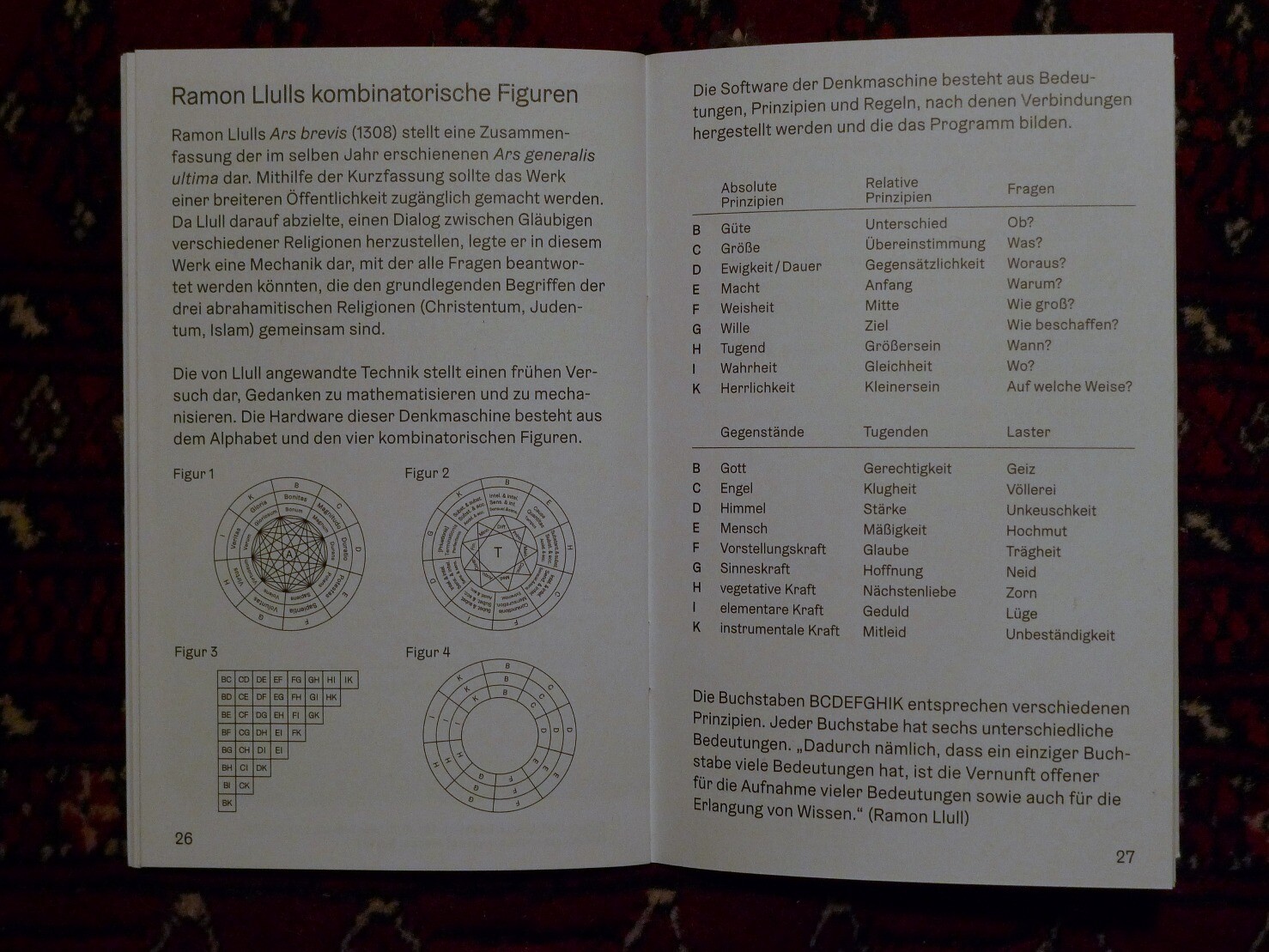
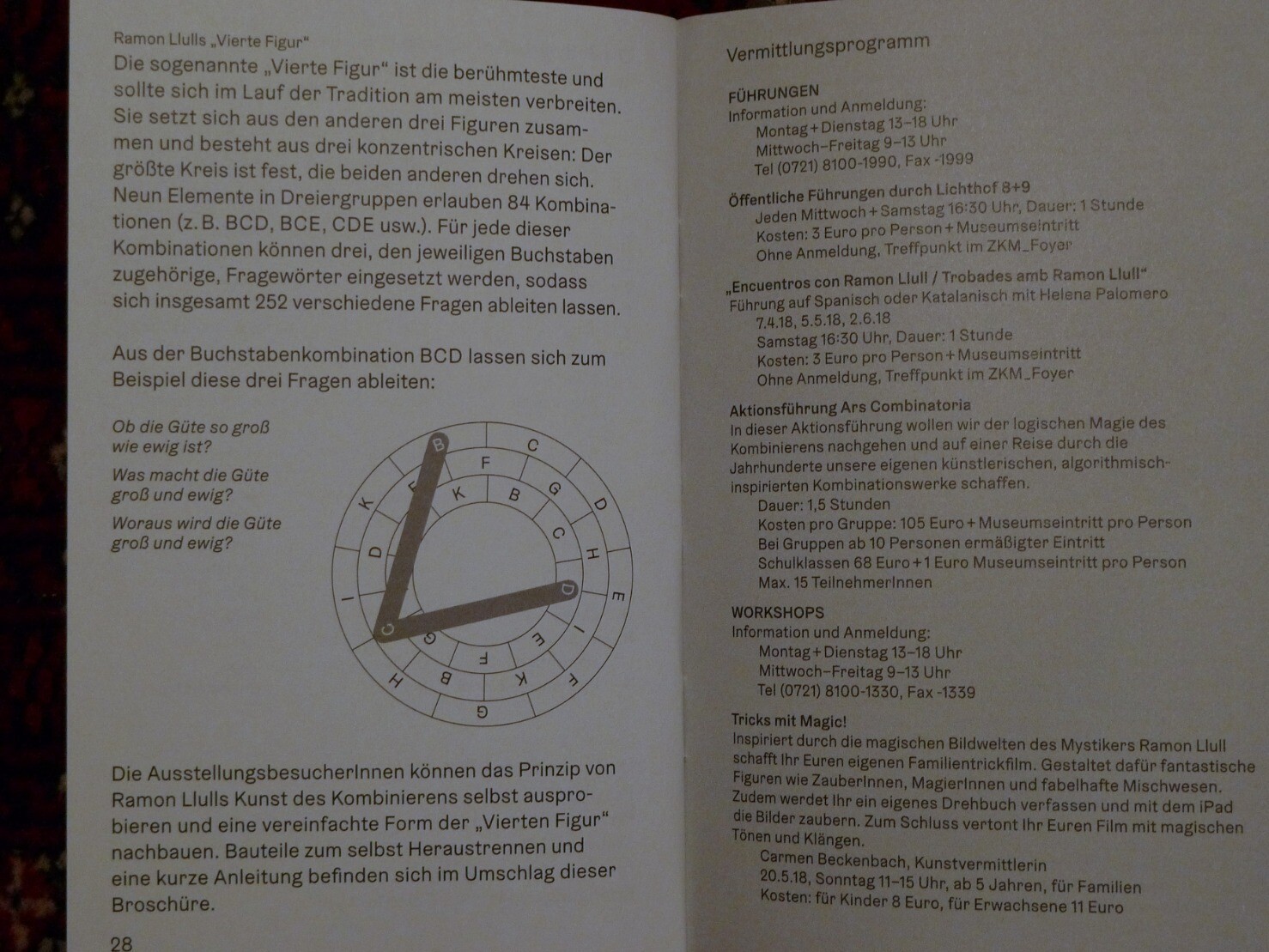
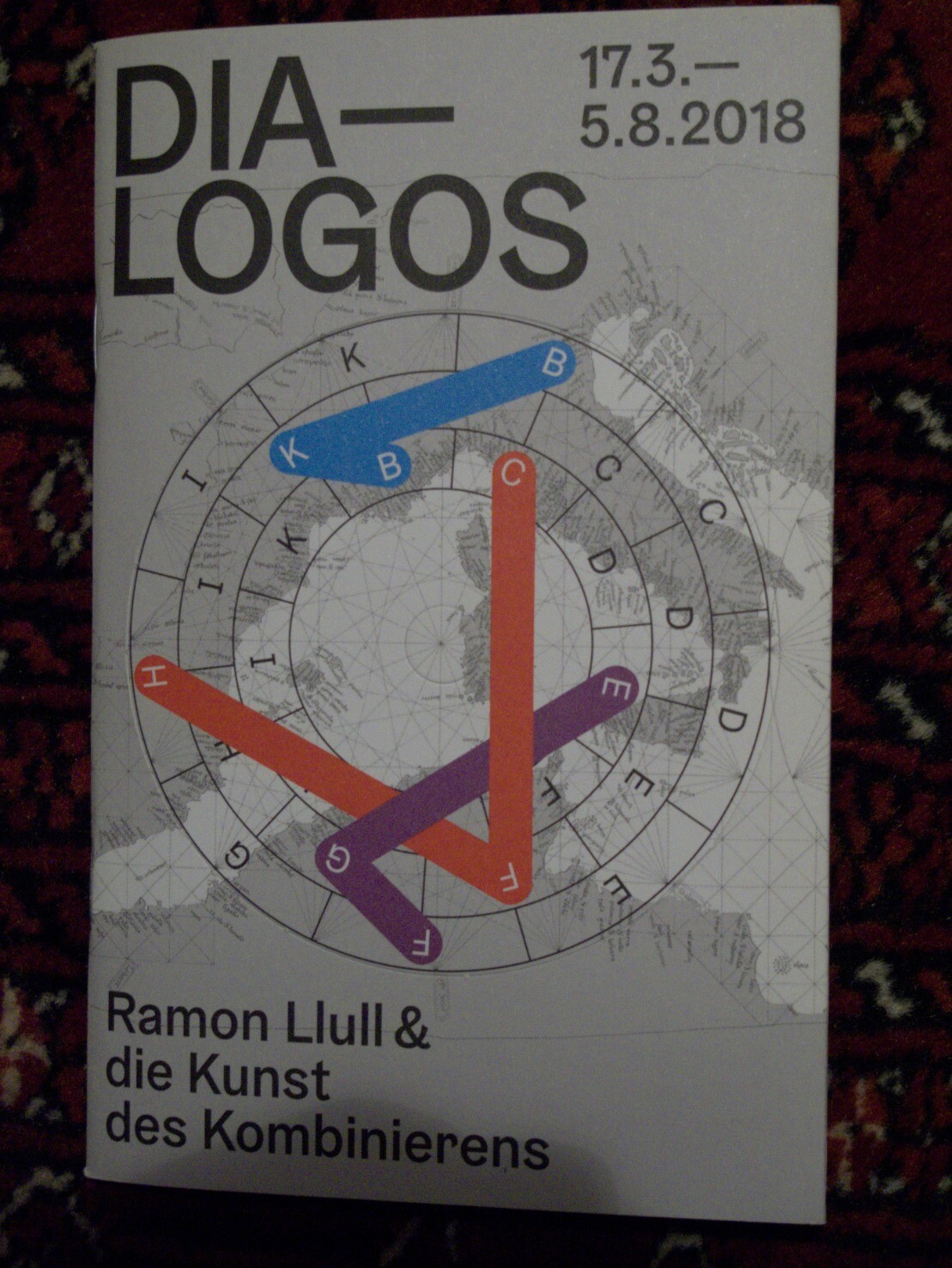
thanks! that's just what I was looking for :D
CJ Eller @cjeller@writing.exchange
Borges wrote a super interesting essay on Llull's "thinking machine" if that helps:
Ramon Llull’s Thinking Machine pdf
note from zen:
Ars generalis ultima, and/or Ars brevis (1308), was Ramon Llull’s
book on thinking machines. this exhibition is art made in response to that book.
see coloring computers , re:
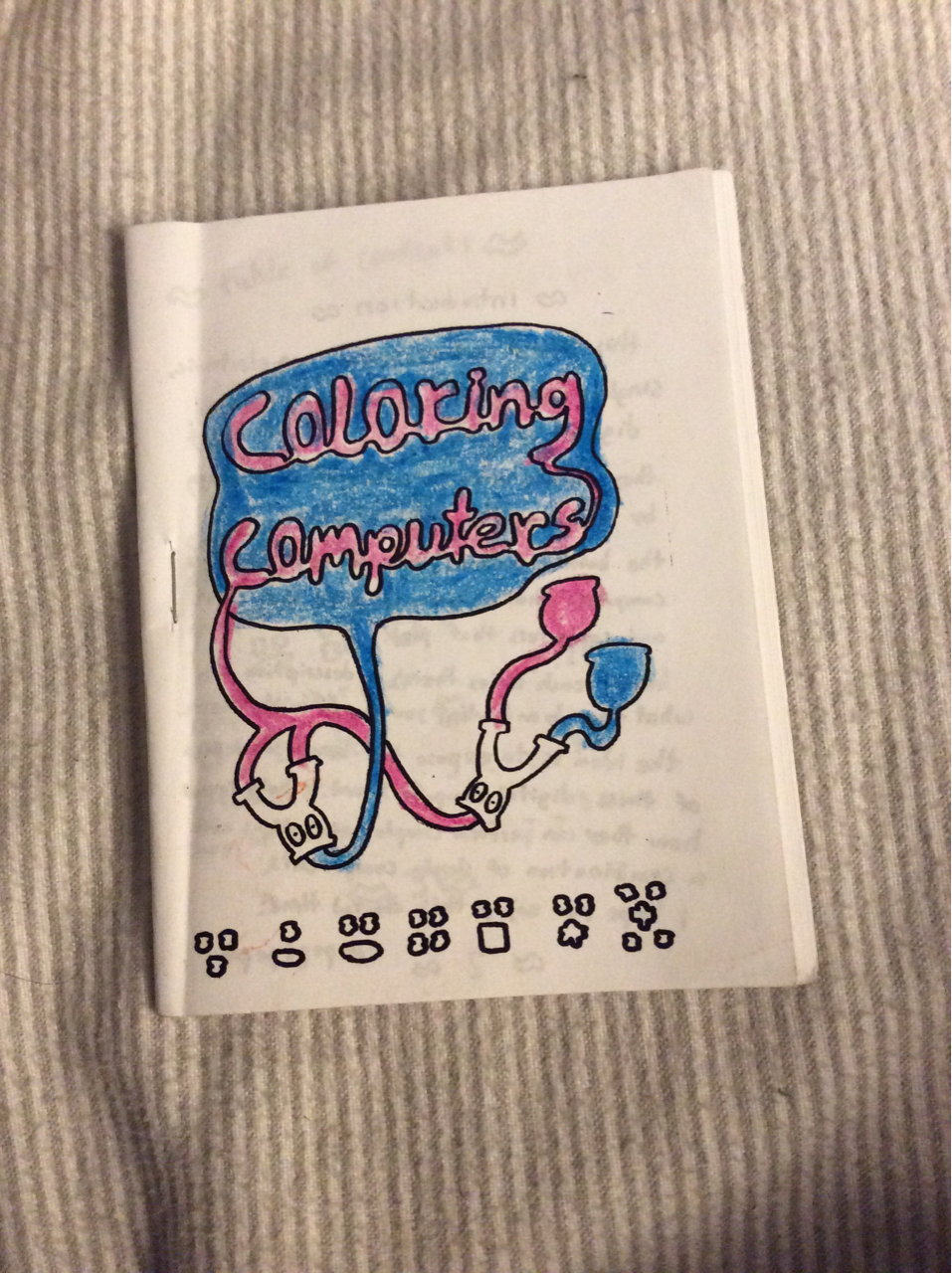

you can find (and pin?) them over here!
we also had a project of choreographic computers; in this one we performed an implementation of an universal turing machine described by minksy in computation: finite and infinite machines (1967)
la consagración de la computadora the rite of computing/
! i invite you to print and try them!
i know lee loved playing with them, and i loved designing and drawing them :)
woah! these are amazing :D
Elias Mårtenson @loke@functional.cafe
I think this is a neat way to use marbles to perform binary computations:
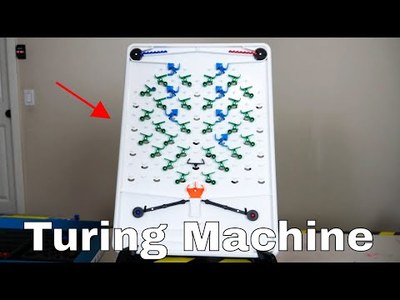
Bevilacqua Gustavino @GustavinoBevilacqua@mastodon.cisti.org
In 1670 Juan Caramuel wrote about "De Binaria Arithmetica": his numbers were made with "0" and "a" rather than with "0" and "1", but the concept was clear.
Take a look at the whole book, you'll find good clues.
Mathesis BicepsL Binary Math 1670
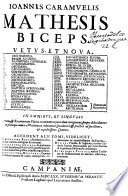
Ryan Medeiros @Lofenyy@mastodon.technology
Bruce Schneier once developed a stream cypher that only uses a deck of cards.
Marius Orcsik @mariusor@metalhead.club
what Bruce did was to detail the Pontifex/Solitare system described in Neal Stephenson's Cryptonomicon.
https://www.schneier.com/academic/solitaire/
Ryan Medeiros @Lofenyy@mastodon.technology
He didn't just detail it he actually designed it himself at the request of the author.
Charles Reids' slide on low and no-tech computing were really cool. I was thinking the other day about whether or not we could use tidal forces for general purpose computation
lono computing: low or no power computers
YHANCI~1.TXT @yhancik@octodon.social
the concept f "low-power no-power" computing :
YHANCI~1.TXT @yhancik@octodon.social
the forgotten computer of Semen Korsakov
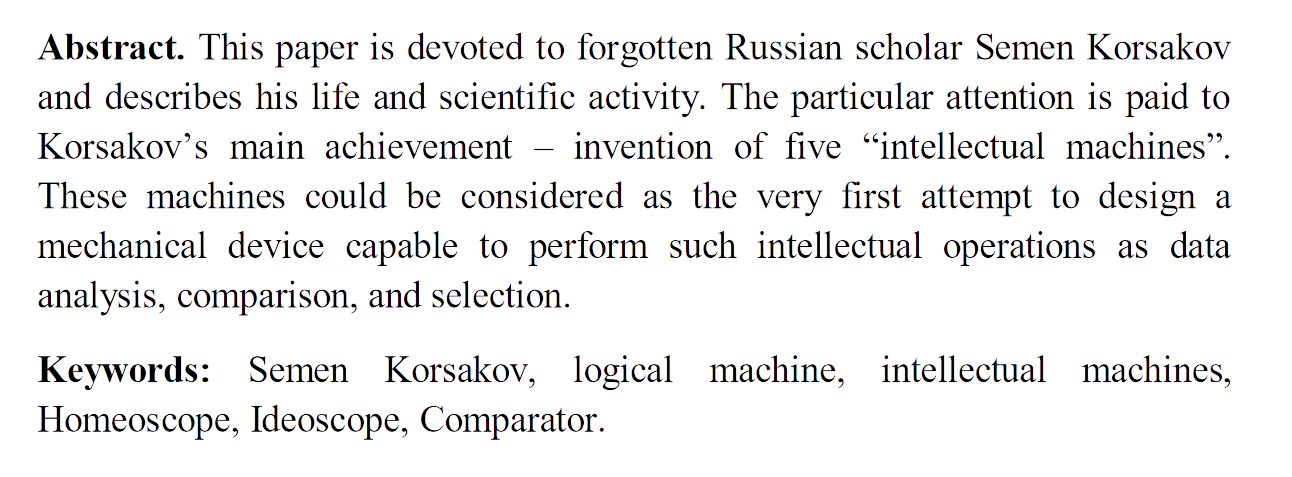
YHANCI~1.TXT @yhancik@octodon.social
this bit by Ada Lovelace, writing about the Analytical Engine, where she imagined computer-generated music
Ada Lovelace imagining music on Babbage’s mchine.
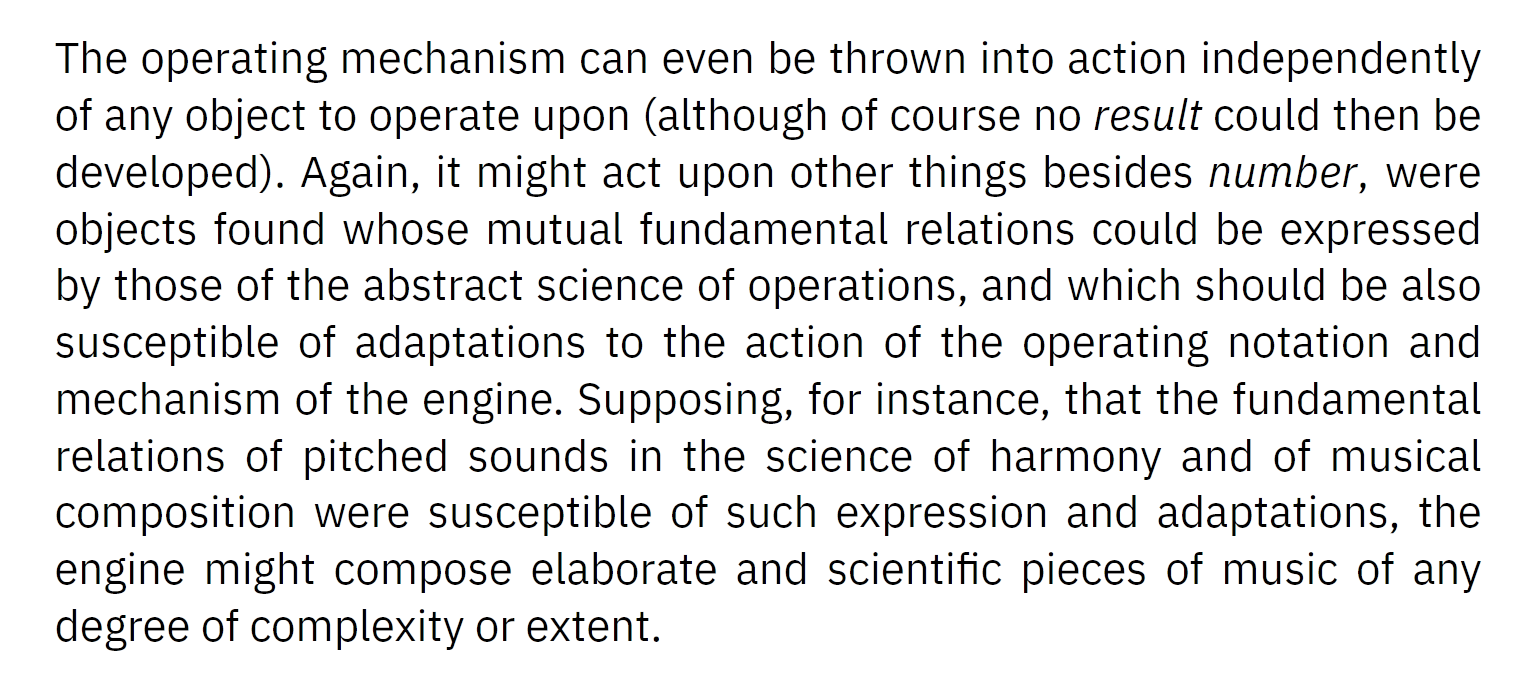
Florian Schmidt @schmidt_fu@mstdn.social
The German cyberneticist Frederic Vester proposed a technique literally called "the paper computer". It was used to teach systems science, esp. to calculate how influential different variables in a
#ComplexSystem are. Sadly since the concept was commercialised, documentation is a bit hard to find.
Here's a German article:
https://de.m.wikipedia.org/wiki/Papiercomputer_(Vester)
JP @pixelpaperyarn@hackers.town
a while back i stumbled on this video of Bubbles Whiting describing her experiences using punch cards.
Bubbles Whiting on her experiences using punchcards (video)
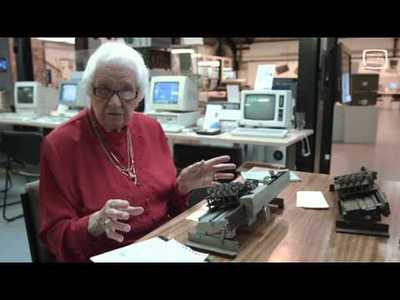
Arjen P. de Vries @arjen@idf.social
seen the recent book BC Before Computers by Stephen Robertson?
BC: Before Computers by Stephen Robertson (book)
I have! Not read it yet tho. It’s on my list.
▼ Platinum Ship of Fools @conatus@octodon.social
I like this video where Matt Parker (and friends) build a logic circuit uit of 10k dominos:
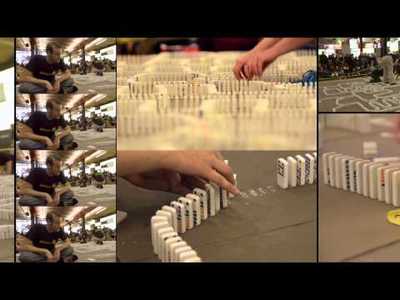
I don't know if Mechanical computers
https://www.youtube.com/watch?v=s1i-dnAH9Y4
https://www.youtube.com/watch?v=hIinz4fKGpo
qualify since they are computers, and were canonical for a long time; There is also the "experiment" of Scott Aaronson
https://www.scottaaronson.com/blog/?m=200708
to disprove this:
https://arxiv.org/abs/cs/0406056
which could be considered as an automated proof without computers (half joke)
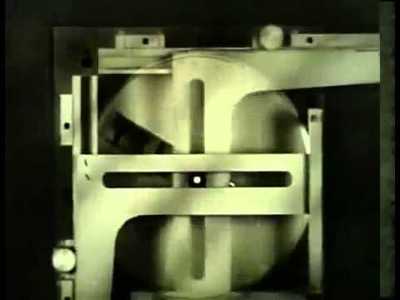
possibly useful is Ben Eater’s series of vids building an 8-bit breadboard computer in that the very concepts of what makes a computer are the subject.
Ben Eater’s series of videos on building a 6502 computer from scratch
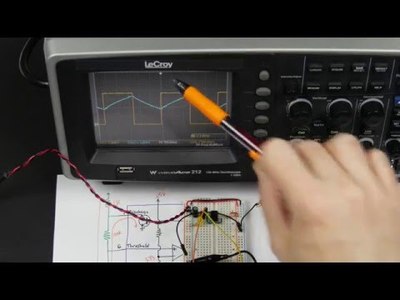
this blog has several articles on rod logic built from lego:
https://www.halfbakedmaker.org/blog/116
nice vid about a mechanical addiator:
https://m.youtube.com/watch?v=cT8fSGHHiAs
museum mura's curta page has some good downloads including most of the mechanical drawings for both models:
https://museummura.li/content.aspx?nid=5051&groupnr=5051
LEGO 1-bit full adder — The Half-Baked Maker
InvisibleUp @invis@glaceon.social
Technology Connections on YouTube has done a few videos on early automated tech.
The most relevant ones are the ones on the automatic jukebox that runs on relays, but check the whole channel out.
https://youtube.com/watch?v=NmGaXEmfTIo
https://youtube.com/watch?v=o1qRzKuskK0
à funky talk by a friend
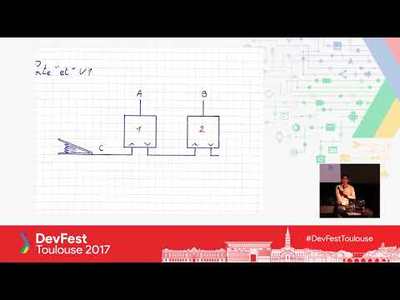
I remember a counting machine using bowls of water filling and emptying to represent 0 and 1 a loooong tim ago and the person who invented it wasn't very interested in it so it was forgotten.
sounds like fluidics
https://miriam-english.org/files/fluidics/FluidControlDevices.html
neat, but i'm exhausted. will try to remember.
Well that's just great. Now my lambda calculus has been replaced by alligators and I'm afraid for my life
Talk about a worry dream!
I used this Wikipedia article when I started uni, that Torus graph is legit amazing
Oh no, i remember doing these in school. It gets pretty mind-bending as the number of inputs increases.
I don't know if that's what you're looking for, but
https://en.wikipedia.org/wiki/Domino_computer
. It's not practical, but I think that blocks falling on other blocks is a good metaphor for today's computer systems.

https://en.wikipedia.org/wiki/Domino_computer
I found this pretty funny/thought-provoking while browsing the esolang wiki:
https://esolangs.org/wiki/Efghij
"Despite its appearance, it is not stack-based." brilliant
waaaat the hell this is another level
Hadn't heard of "paper computing" before but its quite an apt term. While directed towards primary education (and corporate backed), the CSUnplugged project may be worth taking a look at:
Elias Mårtenson @loke@functional.cafe
The best esoteric languages makes you think, and perhaps also learn something about programming.
This is a great example, showing how programmatic structure can be described by things other than a sequence of characters.
My favourite esoteric language that teaches some aspect of computer science is Unlambda. Completely useless to write real code in, but learning it teaches you SKI-calculus.
Dynamic land where paper and projectors are used seems kinda in the spirit,
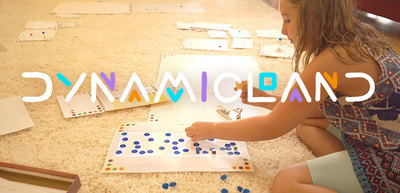
there's a big computer element to this doing computer vision. What I'm looking for is more analog than that.
Michael @fincham@cloudisland.nz
I am a big fan of Irene Posch’s Embroidered Computer using conductive thread and magnets to implement computation on a tapestry:
http://www.ireneposch.net/the-embroidered-computer/
It’s beautiful
ColinTheMathmo @ColinTheMathmo@mathstodon.xyz
This might be of interest ...
https://www.solipsys.co.uk/Chartodon/DevineLuLinvega.svg
Humberto Ortiz-Zuazaga @humberto@mastodon.online
Egyptian multiplication (in binary)
https://en.wikipedia.org/wiki/Ancient_Egyptian_multiplication
"Smith Chart" is used and still taught in electrical engineering . its a picture that lets you quickly find a solution to a few types of otherwise more involved calculations. some people have tattoos of it.
yup that’s a classic one. I already have that one down :)
my prayer has always been love @xj9
this is an area that i need to spend more time reading about! used to be a keen interest of mine as a teen, but that's a complicated time.
Sorry I'm late. Here's a good article on fluidics, with a couple of charts translating familiar digital logic gates to fluidic logic gates:
http://nummolt.blogspot.com/2016/05/fluidic-computers-logic-gates.html
MIT has held a conference in microfluidics:
http://cba.mit.edu/events/07.05.fluid/
The most common application of fluidic logic is in cars most automatic transmissions are basically hydraulic computers that take several inputs and compute which gear to be in. The trick is in building them so the 'output' is in the clutches...
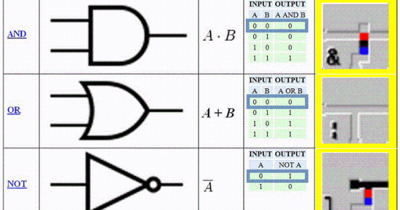
http://nummolt.blogspot.com/2016/05/fluidic-computers-logic-gates.html
mentats & other human computers from dune
Brendan Howell @praxeology@post.lurk.org
You're probably familiar with Jacquard looms.
And I know you know about Zettelkasten – but there were a whole bunch of (largely German) artists and academics who used unusual paper "database" techniques for their work: Luhmann, Arno Schmidt, Kittler, Rolf Dieter Brinkmann.
Markus Krajewski wrote a really cool book¹ about the history of card systems called "Paper Machines".
There was an exhibition about Zettekästen and the catalog² is all in German but it has a ton of really nice images of all kinds of professional, artistic and amateur card archives.
- https://monoskop.org/log/?p=4076
- http://www.jean-paul-2013.de/jubilaeum/publikationen/ausstellungskataloge/zettelkaesten-maschinen-der-phatasie.html
- https://monoskop.org/log/?p=4076
There was also the proto-wiki the Mundaneum:
https://en.wikipedia.org/wiki/Mundaneum
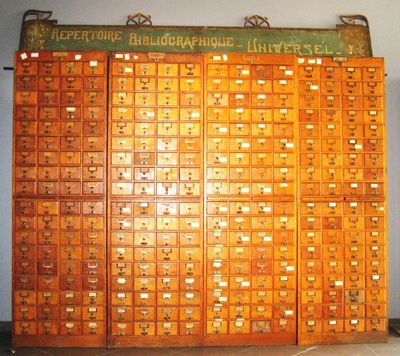
https://en.wikipedia.org/wiki/Mundaneum
I was part of some algorithmic performances using paper and dice to take "random walks" or generate markov chains. Sadly can't find any video for these:
https://transmediale.de/de/content/cqrrelations
But here's some audio of our earlier radio show in mixed french and english where we do some algorithmic card performance:
http://desert.numerique.free.fr/archives/?id=1011&ln=
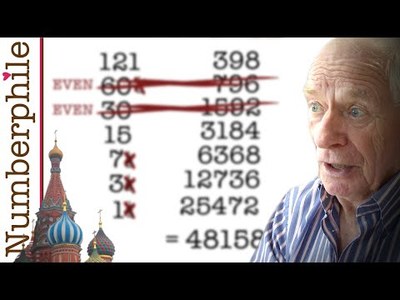
are you interested in other numerical representations that simplify calculation as well? If so, you might want to look in to Kaktovik Inupaq. It makes simple arithmetic in to concatenation and multiplication and division visual.
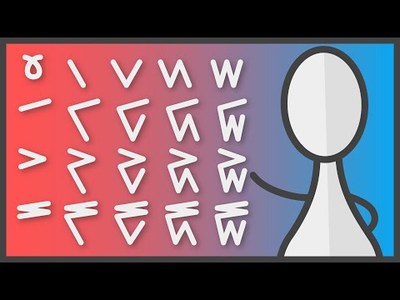
now let's say you're using the Russian (Egyptian) multiplication system. Using arabic numerals you need to first convert it to binary. Wouldn't it be nice if we could do that visually? Wouldn't it be nice to have a featural number system that was like... Binary and hex at the same time?
so this is Kaktovik but hexadecimal. :)
It lets you not only do the same visual addition and subtraction as Kaktovik Inupaq, but also makes Xor visual and makes it trivial to directly use binary multiplication and division which is way easier than decimal.
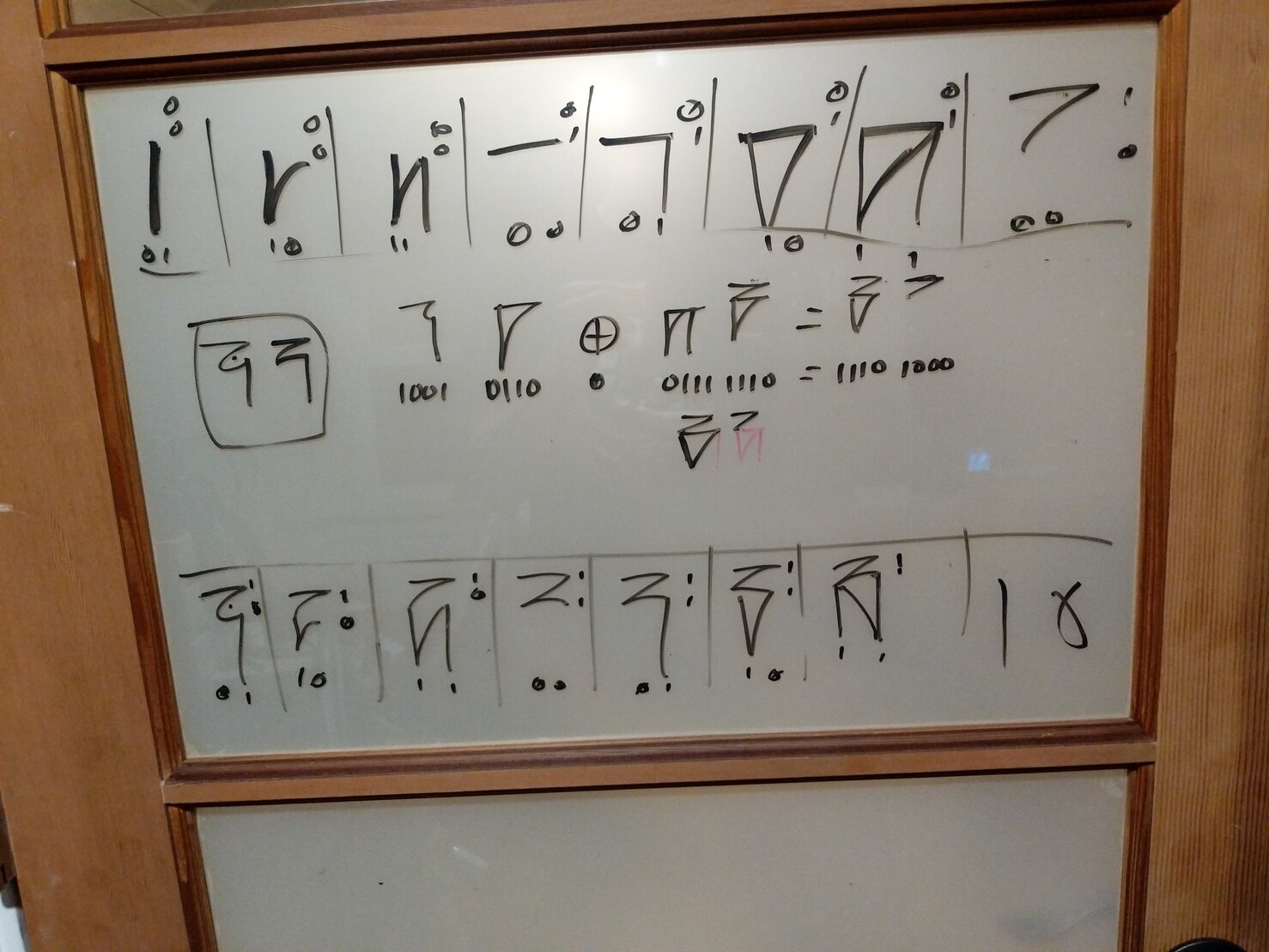
yeah :D I like that, I have that in my math section, not in paper programming as it's not really visual.
http://www.cut-the-knot.org/Curriculum/Algebra/PeasantMultiplication.shtml
Automatic theatres in the ancient Greek world. Complex animated sequences controlled by thread-based logic.
kotsanas.com/gb/exh.php?exhibi…
Many mechanical music instruments of the 19th century had similar ambitions. Their programs were usually stored on a punched tape (piano roll).
Ethnomathematics and ethnocomputing are a treasure trove in general. A typical topic is the Inca quipu system analyzed as a tree-like data structure. I personally find binary-combinatoric divination systems intriguing (i.e. I Ching, Geomancy, Ifa). Geomancy randomizes 16 bits and then generates many more bits with XOR operation. They even built mechanical devices that automatize the XOR part
vacapintasbritishmuseum.wordpr… .
In the Yoruba Ifa tradition, 8-bit sequences are used as kind of hash references to their oral tradition (i.e. if you know the songs mapped to each byte, you know their literary canon).
Pāṇini’s Sanskrit grammar is widely known to use an early equivalent of Backus-Naur form, and I have heard rumors that some sets of the transformation rules have been proven Turing-complete (as in “repeat the sandhi process and you’ll get something out of which you can build a tag system”)
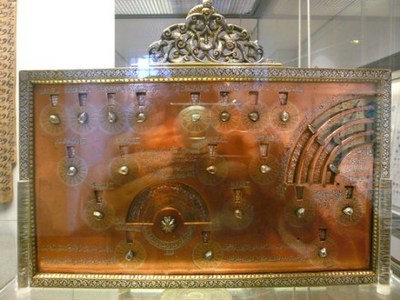
Dr. Nim… A boardgame from the 1960s with a mechanical AI:
Cristi Constantin @croqaz@social.privacytools.io
Paper encryption, in case you need it:
Strong pen & paper cipher: Sarah2:
And there’s also: Solitaire:
https://en.wikipedia.org/wiki/Solitaire_(cipher)
Sorry I’m late to the party.
I know this is not a computer, it’s just a huge pinball machine, but just listen:
youtube.com/watch?v=IvUU8joBb1
Just to add to this thread (this is my last comment, no more spam)
The only reason we have electronic computers IMO is because when Tesla asked for funding for his research, the guys that funded him had a copper wire factory and they wanted to make a good business.
Also electricity is easy to measure and make profit.
It has to be something easy to measure, because it’s all about money.

